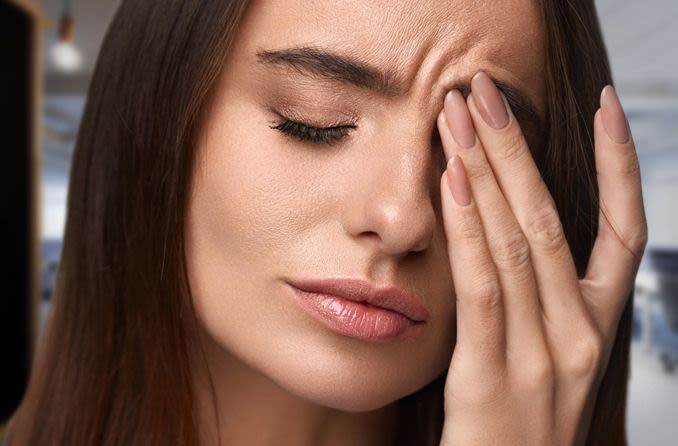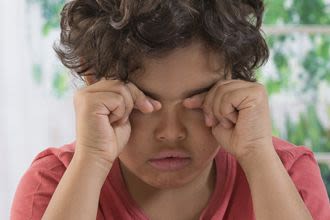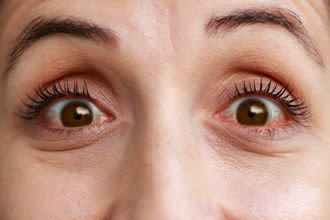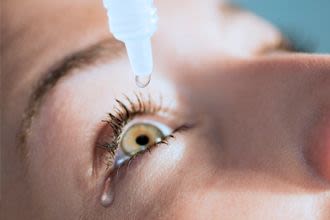7 everyday things that can hurt your eyes

Every day — in some cases every hour and long into the night — we check our phones or play games on our digital devices.
Long walks on the beach and hikes in the woods are great, but without sunglasses, we put our vision at risk. In fact, many of us practice seven common behaviors that can lead to painful eye conditions and even blindness.
How many of these have you done today?
1. Too much screen time
Don’t look at your smartphones, tablets or e-readers before bedtime — this will reduce digital eye strain and make it easier to fall asleep.

You may want to cut your screen time down even more.
The average American spends seven hours a day on their digital devices, the American Optometric Association (AOA) found. The same survey also revealed 58% of adults have experienced computer vision syndrome, or digital eye strain, as a result.
Screen time is also a big problem with tweens and teens. On average, 8- to 12-year-olds in the U.S. spend just under five hours screening digital entertainment per day, according to Common Sense Media’s 2019 Common Sense Census.
According to Barbara L. Horn, O.D., president of the AOA, digital eye strain can be caused by using your devices in poor lighting (like in the dark before bed), a glare on your screen and improper viewing distances.
Symptoms of digital eye strain include headaches, blurred vision, dry eyes, neck and shoulder pain, eye irritation and difficulty falling asleep.
“While there is not a standardized number of hours adults should limit their screen time to, people who spend two or more continuous hours at a computer or using a digital screen device every day are at a greater risk of experiencing eye strain,” Horn says.
SEE RELATED: Is too much screen time bad for kids?
WANT TO SHOP FOR BLUE LIGHT GLASSES? Find an optical store near you or shop online.
2. Rubbing your eyes
How many times a day do you rub your eyes? For some of us, it’s too many to count, and that’s a problem. Rubbing your eyes can lead to scratched corneas, cause eye disease and exacerbate existing vision problems.

Rubbing your eyes also can result in blindness by way of a condition called keratoconus.
Then, there’s the risk for eye infections.
“No matter how often you wash or sanitize your hands, they can still pick up thousands of germs every day,” Horn says. “Touching your eyes with your hands can transfer bacteria that can cause conjunctivitis or pink eye.”
Instead of rubbing your eyes when you feel something in them, like an eyelash or dust, Horn suggests rinsing your eyes with water or saline.
3. Wearing contact lenses wrong
A common thread among contacts wearers is that they know the rules of contact lens care — they simply don’t follow them.

The AOA found up to 90% of contact lens wearers don’t follow proper hygiene instructions, which can pose serious risks to the health of their eyes and vision.
The Centers for Disease Control and Prevention (CDC) found that most of the 45 million contact lens wearers in the U.S. practice at least some behaviors that put them at risk for serious eye infections.
“Many common care mistakes include failing to clean and store lenses as directed by a doctor of optometry and sleeping while wearing contacts,” Horn says.
“In fact, sleeping in contacts is one of the most frequently reported lens-related habits and is known to increase the risk for a serious eye infection,” she adds.
Surveys have found that about 1 in 3 people who wear contact lenses sleep or nap in them, which can lead to inflammation, dry eye, pain, blurry vision and light sensitivity.
A 2018 survey for the CDC found that 32.9% of contact lens wearers age 18 or over didn’t recall hearing any lens wear or care recommendations. Fewer than half (47.9%) of those surveyed didn’t remember hearing their eye care professional tell them not to sleep in their contact lenses.
Yes, there are contact lenses approved for overnight use, but even those could deprive your eyes of oxygen and should be taken out regularly to give your eyes a break, Horn says.
In addition to not wearing your contacts when sleeping, you also shouldn’t wear your contacts in the shower or pool. It can increase the chances of bacteria getting into your eyes, leading to infection.
“Contact lens wearers who don't follow their eye doctor’s recommendations for use and wear can experience symptoms such as blurred or fuzzy vision, red or irritated eyes, pain in and around the eyes,” Horn says “or a more serious condition in which the cornea becomes inflamed, also known as keratitis.”
4. Not wearing sunglasses
Before stepping out into the sun, you should always grab a pair of shades. It’s the best way to protect your eyes from ultraviolet (UV) radiation.

People who spend a lot of time outdoors obviously have a higher risk for harm to their eyes, but short-term exposure can also be a problem. Horn says just one day at the beach without eye protection can lead to photokeratitis, also known as “sunburn of the eye,” which is temporary but painful.
In the long term, damage from UV rays can lead to serious conditions like cataracts and pterygium, which causes an abnormal covering on the white of the eye.
Not wearing sunglasses outside also puts you at risk for cancer — of the eyelids, the skin around the eye and even the eye itself.
“Having the appropriate eye protection is especially important for children and teenagers, since they typically spend more time in the sun than adults,” Horn says. “Unlike the lens found in an adult eye, which is more mature, a child's lens cannot filter out UV rays as easily, possibly causing damage to the retina.”
The average child is exposed to about three times the annual UV exposure as an adult, according to the AOA, and up to 80% of lifetime UV exposure occurs before age 20.
Just as important as wearing sunglasses is making sure you’re wearing a pair with the most protection from UV rays. Horn says you should look for sunglasses with 99% to 100% UV protection that screen out 75% to 90% of visible light.
Of course, more expensive prescription sunglasses are more likely to offer better UV protection, but you should still be able to find shades to fit the bill at your favorite discount department store.
5. Going heavy on the eye drops
Eye drops are a popular way to get relief from red, itchy, watery or dry eyes, but improper or prolonged use can sometimes make things worse.

For example, those lubricating eye drops used to relieve dryness and irritation caused by insufficient tear production can wash away your natural tears.
“Prolonged use and/or overuse can cause a dependency on the drops to soothe and moisturize the eyes, as well as protect delicate eye layers,” Horn says. “Glands get clogged because they don’t secrete the proper oils to hold the tears in place and make the eyes feel comfortable.”
Horn also warns that whitening eye drops (to get the red out) can decrease blood flow, preventing essential oxygen and nutrients from getting to the eye. Your blood vessels could then grow enlarged and become even redder as they struggle to deliver oxygen.
As for allergy eye drops, they can provide temporary relief, but it’s important to fix the underlying cause of the allergic response so you aren’t using them too much.
If your eye problems get worse while using drops, Horn says it’s important to see your eye doctor, who could recommend light massage routines for the eyelids and better products.
6. Smoking
People who light up are damaging their lungs and hurting their eyes. Smoking can lead to serious eye conditions that can cause vision loss or blindness.

According to the CDC, two of the biggest threats for smokers are macular degeneration and cataracts.
Macular degeneration can impact your central vision, which you need to see objects clearly and perform tasks like reading and driving. Macular degeneration can also make it harder for you to recognize faces.
Cataracts cause blurry vision and worsen over time, leading to significant vision loss if not surgically treated.
The best way to protect yourself from developing macular degeneration and cataracts? Stop smoking immediately.
SEE RELATED: Vaping, like smoking, may harm your eyes
7. Skipping regular eye exams
Skipping regular eye exams isn’t something people are doing every day, obviously, but if it’s been more than a year since your last eye exam, you’re making the daily decision not to prioritize your health.

“A comprehensive eye exam can reveal more than just vision issues,” Horn says. “Through an eye exam, an eye doctor can directly view inside of the eye including the retina, blood vessels and the optic nerves, which are a direct extension of the brain.”
Many health problems in other parts of your body can affect your eyes. For example, people with diabetes and hypertension, and those who take medicine with eye-related side effects have a greater risk of developing vision issues.
Your vision will continue to change as you get older, sometimes getting worse. People 60 years and older can start developing age-related issues, putting them at risk for vision loss if they don’t get eye exams regularly.
“Many eye diseases have no early symptoms,” Horn says. “They may develop painlessly, and you may not notice the changes to your vision until the condition is quite advanced.”
The AOA recommends eye exams at least once a year to protect your eye and vision health.
WHEN WAS YOUR LAST EYE EXAM? Find an eye doctor near you and schedule a comprehensive exam.
Page published on Wednesday, October 30, 2019






